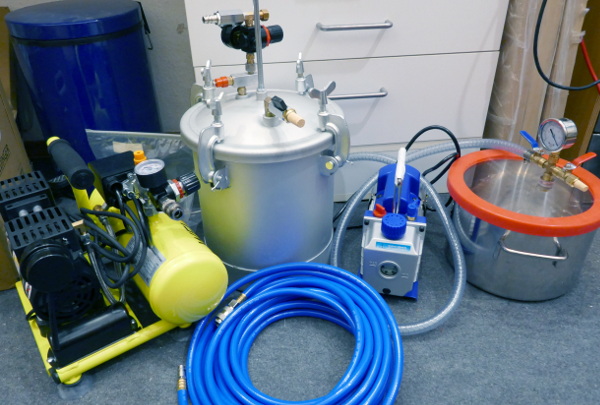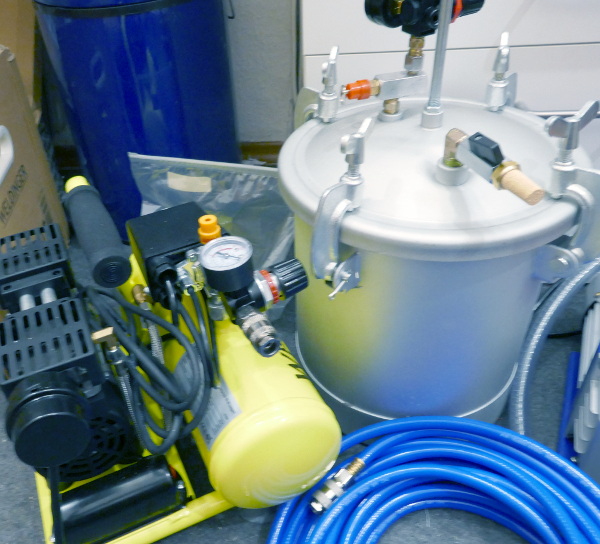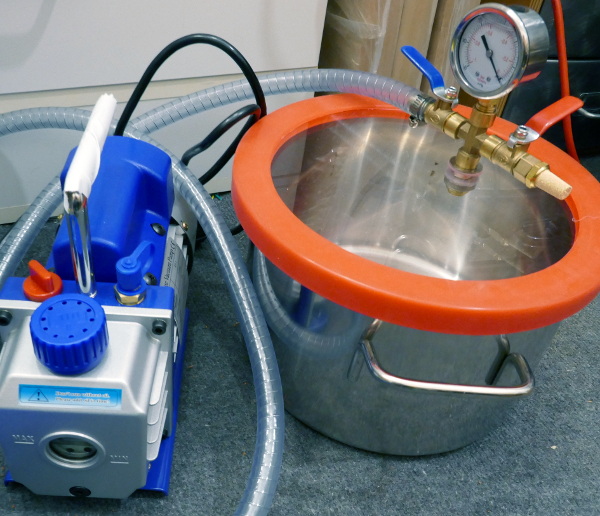| « 2021-06-14 | Tinkering | 2020-11-18 » |
Tinkering: 2020-12-06: Air Pressure
For my alarm clock project, I need better results when working with epoxy glue. The display was constructed from a crystal from glass plus a PCB used as a clock face, and the two are glued together using clear epoxy. The result was OK, but there are tiny bubbles I want to get rid of to have a crystal clear result.
 This is what I got to improve my results. On the left, you can see my new
pressure pot with its air compressor. On the right, there is my new
vacuum pump with its corresponding pot.
This is what I got to improve my results. On the left, you can see my new
pressure pot with its air compressor. On the right, there is my new
vacuum pump with its corresponding pot.
 The high pressure air pot is made for spraying paint. It came with a
spraying tool and valves and hoses, and inside the pot, a pipe goes down
into the paint bucket. I did not need all this painting equipment, so I
cut off that pipe and put the hoses somewhere else. But the
package is a relatively cheap way of getting a pressure pot. I simply
attached valves and a standard air pressure plug so I could use it
for my purposes.
The high pressure air pot is made for spraying paint. It came with a
spraying tool and valves and hoses, and inside the pot, a pipe goes down
into the paint bucket. I did not need all this painting equipment, so I
cut off that pipe and put the hoses somewhere else. But the
package is a relatively cheap way of getting a pressure pot. I simply
attached valves and a standard air pressure plug so I could use it
for my purposes.
The original plumbing comes irreversibly contaminated with sealing glue. I was not able to unscrew anything without fearing to break it. So basically, I attached my stuff to what was there. The pressure control valve that came with the pot is actually handy to set it to 3.5 bars. There is an emergency over-pressure release valve, which is also good. On the outlet, I attached a silencer. It was a bit of a struggle to seal up the new plumbing so that the pot holds its pressure for 24h, but it seems to work now.
The air compressor is a very small one – I do not have that much space and all this necessary(!) junk takes up a lot of space already. The pump is relatively quiet, and it takes only half a minute or so to pressurize the pot (maybe holding 15l) – that's very OK for me.
The pressure chamber will be used for letting the epoxy cure. The pressure will minimise any remaining bubbles to the point where they become invisible. To my understanding, the high pressure also causes the resin to allow more air to dissolve in it, so the air bubbles completely disappear into the resin. At least that's how it works in soda bottles that do not have bubbles under pressure, but do when you open them.
 The vacuum pump was less work to get up and running, because it was
already exactly what I wanted. Unfortunately, the hose stank of cheap
plastic, so I replaced it with a new one. And for convenience, I will
attach another quick release socket + plug.
The vacuum pump was less work to get up and running, because it was
already exactly what I wanted. Unfortunately, the hose stank of cheap
plastic, so I replaced it with a new one. And for convenience, I will
attach another quick release socket + plug.
The vacuum chamber will be used to prepare the epoxy before pouring to remove trapped air from stirring it.
So that's the update on the upgrades. I did not yet do any epoxy work with this, so that's a story for another day.
Also, now that I have this, a few other possibilities open up for using the new pumps: for high pressure: a nail gun! For low pressure: cooking with vacuum! Very interesting prospects on the horizon.